Revising the Static Geological Reservoir Model of the Upper Triassic Stuttgart Formation at the Ketzin Pilot Site for CO2 Storage by Integrated Inverse Modelling
Abstract
:1. Introduction
2. Materials and Methods
2.1. Numerical Forward Models
2.2. Integrated Numerical Inverse Model
3. Results
3.1. Hydraulic Testing Phase
3.2. CO Injection Phase
3.3. Spatial Permeability Distribution in the Revised Reservoir Model
4. Discussion and Conclusions
Acknowledgments
Author Contributions
Conflicts of Interest
References
- Intergovernmental Panel on Climate Change (IPCC). IPCC Special Report on Carbon Dioxide Capture and Storage; Metz, B., Davidson, O., de Coninck, H.C., Loos, M., Meyer, L.A., Eds.; Cambridge University Press: Cambridge, UK; New York, NY, USA, 2005. [Google Scholar]
- Raven, J.; Caldeira, K.; Elderfield, H.; Hoegh-Guldberg, O.; Liss, P.S.; Riebesell, U.; Sheperd, J.; Turley, C.; Watson, A. Ocean Acidification due to Increasing Atmospheric Carbon Dioxide. Royal Society Policy Document. 2005. Available online: https://royalsociety.org/~/media/Royal_Society_Content/policy/publications/2005/9634.pdf (accessed on 22 September 2017).
- Schilling, F.; Borm, G.; Würdemann, H.; Möller, F.; Kühn, M.; CO2SINK Group. Status Report on the First European On-Shore CO2 Storage Site at Ketzin (Germany). Energy Procedia 2009, 1, 2029–2035. [Google Scholar] [CrossRef]
- Würdemann, H.; Möller, F.; Kühn, M.; Heidug, W.; Christensen, N.P.; Borm, G.; Schilling, F. CO2SINK—From site characterisation and risk assessment to monitoring and verification: One year of operational experience with the field laboratory for CO2 storage at Ketzin, Germany. Int. J. Greenh. Gas Control 2010, 4, 938–951. [Google Scholar] [CrossRef]
- Martens, S.; Liebscher, A.; Möller, F.; Würdemann, H.; Schilling, F.; Kühn, M.; Ketzin Group. Progress Report on the First European on-shore CO2 Storage Site at Ketzin (Germany)—Second Year of Injection. Energy Procedia 2011, 4, 3246–3253. [Google Scholar] [CrossRef]
- Martens, S.; Kempka, T.; Liebscher, A.; Lüth, S.; Möller, F.; Myrttinen, A.; Norden, B.; Schmidt-Hattenberger, C.; Zimmer, M.; Kühn, M.; et al. Europe’s longest-operating on-shore CO2 storage site at Ketzin, Germany: A progress report after three years of injection. Environ. Earth Sci. 2012, 67, 323–334. [Google Scholar] [CrossRef]
- Martens, S.; Liebscher, A.; Möller, F.; Henninges, J.; Kempka, T.; Lüth, S.; Norden, B.; Prevedel, B.; Szizybalski, A.; Zimmer, M.; et al. CO2 storage at the Ketzin pilot site: Fourth year of injection, monitoring, modelling and verification. Energy Procedia 2013, 37, 6434–6443. [Google Scholar] [CrossRef]
- Martens, S.; Möller, F.; Streibel, M.; Liebscher, A.; the Ketzin Group. Completion of five years of safe CO2 injection and transition to the post-closure phase at the Ketzin pilot site. Energy Procedia 2015, 59, 190–197. [Google Scholar] [CrossRef]
- Bielinski, A. Numerical Simulation of CO2 Sequestration in Geological Formations. Mitteilungsheft Nr. 155. Ph.D. Thesis, Department of Hydraulic Engineering, University of Stuttgart, Stuttgart, Germany, 2007. [Google Scholar]
- Probst, P. Numerical Simulations of CO2 Injection into Saline Aquifers: Estimation of Storage Capacity and Arrival Times using Multiple Realizations of Heterogeneous Permeability Fields. Master’s Thesis, Department of Hydraulic Engineering, University of Stuttgart, Stuttgart, Germany, 2008. [Google Scholar]
- Kempka, T.; Kühn, M.; Class, H.; Frykman, P.; Kopp, A.; Nielsen, C.M.; Probst, P. Modelling of CO2 arrival time at Ketzin—Part I. Int. J. Greenh. Gas Control 2010, 4, 1007–1015. [Google Scholar] [CrossRef]
- Kempka, T.; Kühn, M. Numerical simulations of CO2 arrival times and reservoir pressure coincide with observations from the Ketzin pilot site, Germany. Environ. Earth Sci. 2013, 70, 3675–3685. [Google Scholar] [CrossRef]
- Kempka, T.; Class, H.; Görke, U.J.; Norden, B.; Kolditz, O.; Kühn, M.; Walter, L.; Wang, W.; Zehner, B. A Dynamic Flow Simulation Code Intercomparison based on the Revised Static Model of the Ketzin Pilot Site. Energy Procedia 2013, 40, 418–427. [Google Scholar] [CrossRef]
- Kempka, T.; De Lucia, M.; Kühn, M. Geomechanical integrity verification and mineral trapping quantification for the Ketzin CO2 storage pilot site by coupled numerical simulations. Energy Procedia 2014, 63, 3330–3338. [Google Scholar] [CrossRef]
- Kempka, T.; Klein, E.; De Lucia, M.; Tillner, E.; Kühn, M. Assessment of Long-term CO2 Trapping Mechanisms at the Ketzin Pilot Site (Germany) by Coupled Numerical Modelling. Energy Procedia 2013, 37, 5419–5426. [Google Scholar] [CrossRef]
- Norden, B.; Frykman, P. Geological modelling of the Triassic Stuttgart Formation at the Ketzin CO2 storage site, Germany. Int. J. Greenh. Gas Control 2013, 19, 756–774. [Google Scholar] [CrossRef]
- Ouellet, A.; Bérard, T.; Desroches, J.; Frykman, P.; Welsh, P.; Minton, J.; Pamukcu, Y.; Hurter, S.; Schmidt-Hattenberger, C. Reservoir geomechanics for assessing containment in CO2 storage: A case study at Ketzin, Germany. Energy Procedia 2011, 4, 3298–3305. [Google Scholar] [CrossRef]
- Norden, B. Modelling of the near-surface groundwater flow system at the CO2SINK site Ketzin, Germany. Z. Dtsch. Ges. Geowiss. 2011, 162, 63–77. [Google Scholar] [CrossRef]
- Klein, E.; De Lucia, M.; Kempka, T.; Kühn, M. Evaluation of long-term mineral trapping at the Ketzin pilot site for CO2 storage: An integrative approach using geochemical modelling and reservoir simulation. Int. J. Greenh. Gas Control 2013, 19, 720–730. [Google Scholar] [CrossRef]
- De Lucia, M.; Kempka, T.; Kühn, M. A coupling alternative to reactive transport simulations for long-term prediction of chemical reactions in heterogeneous CO2 storage systems. Geosci. Model Dev. 2015, 8, 279–294. [Google Scholar] [CrossRef]
- Govindan, R.; Babaei, M.; Korre, A.; Shi, J.Q.; Durucan, S.; Norden, B.; Kempka, T. CO2 Storage Uncertainty and Risk Assessment for the Post-closure Period at the Ketzin Pilot Site in Germany. Energy Procedia 2014, 63, 4758–4765. [Google Scholar] [CrossRef]
- Kempka, T.; Klapperer, S.; Norden, B. Coupled hydro-mechanical simulations demonstrate system integrity at the Ketzin pilot site for CO2 storage, Germany. In Proceedings of the ISRM Regional Symposium—EUROCK 2014, Vigo, Spain, 27–29 May 2014. [Google Scholar]
- Baumann, G.; Henninges, J.; De Lucia, M. Monitoring of saturation changes and salt precipitation during CO2 injection using pulsed neutron-gamma logging at the Ketzin pilot site. Int. J. Greenh. Gas Control 2014, 28, 134–146. [Google Scholar] [CrossRef]
- Fischer, S.; Liebscher, A.; Zemke, K.; De Lucia, M.; the Ketzin Team. Does Injected CO2 Affect (Chemical) Reservoir System Integrity?—A Comprehensive Experimental Approach. Energy Procedia 2013, 37, 4473–4482. [Google Scholar] [CrossRef]
- Fischer, S.; Liebscher, A.; De Lucia, M.; Hecht, L.; the Ketzin Team. Reactivity of sandstone and siltstone samples from the Ketzin pilot CO2 storage site-Laboratory experiments and reactive geochemical modeling. Environ. Earth Sci. 2013, 70, 3687–3708. [Google Scholar] [CrossRef]
- Fischer, S.; De Lucia, M.; Liebscher, A. Kinetic modeling of laboratory CO2-exposure experiments performed on whole rock reservoir samples. Greenh. Gases 2014, 4, 244–256. [Google Scholar] [CrossRef]
- Lengler, U.; De Lucia, M.; Kühn, M. The impact of heterogeneity on the distribution of CO2: Numerical simulation of CO2 storage at Ketzin. Int. J. Greenh. Gas Control 2010, 4, 1016–1025. [Google Scholar] [CrossRef]
- Bergmann, P.; Lengler, U.; Schmidt-Hattenberger, C.; Giese, R.; Norden, B. Modelling the geoelectric and seismic reservoir response caused by carbon dioxide injection based on multiphase flow simulation: Results from the CO2SINK project. Chem. Erde Geochem. 2010, 70, 173–183. [Google Scholar] [CrossRef]
- Martens, S.; Kempka, T.; Liebscher, A.; Möller, F.; Schmidt-Hattenberger, C.; Streibel, M.; Szizybalski, A.; Zimmer, M. Field Experiment on CO2 Back-production at the Ketzin Pilot Site. Energy Procedia 2015, 76, 519–527. [Google Scholar] [CrossRef]
- Unger, V.; Kempka, T. Hydro-mechanical Simulations of Well Abandonment at the Ketzin Pilot Site for CO2 Storage Verify Wellbore System Integrity. Energy Procedia 2015, 76, 592–599. [Google Scholar] [CrossRef]
- Wagner, F.M. New Developments in Electrical Resistivity Imaging with Applications to Geological CO2 Storage. Ph.D. Thesis, ETH Zürich, Zürich, Switzerland, 2016. [Google Scholar]
- Kempka, T.; Norden, B. Inverse modelling of hydraulic testing to revise the static reservoir model of the Stuttgart Formation at the Ketzin pilot site. Energy Procedia 2017, 125, 640–649. [Google Scholar] [CrossRef]
- Huang, F.; Juhlin, C.; Han, L.; Sopher, D.; Ivandic, M.; Norden, B.; Deng, W.; Zhang, F.; Kempka, T.; Lüth, S. Feasibility of utilizing wavelet phase to map the CO2 plume at the Ketzin pilot site, Germany. Geophys. Prospect. 2017, 65, 523–543. [Google Scholar] [CrossRef]
- Huang, F.; Juhlin, C.; Han, L.; Kempka, T.; Lüth, S.; Zhang, F. Quantitative evaluation of thin-layer thickness and CO2 mass utilizing seismic complex decomposition at the Ketzin CO2 storage site, Germany. Geophys. J. Int. 2016, 207, 160–173. [Google Scholar] [CrossRef]
- Huang, F.; Bergmann, P.; Juhlin, C.; Ivandic, M.; Lüth, S.; Ivanova, A.; Kempka, T.; Henninges, J.; Sopher, D.; Zhang, F. The First Post-injection Seismic Monitor Survey at the Ketzin Pilot CO2 Storage Site: Results from Time-lapse Analysis. Geophys. Prospect. 2016. [Google Scholar] [CrossRef]
- Huang, F.; Juhlin, C.; Kempka, T.; Norden, B.; Zhang, F. Modeling 3D time-lapse seismic response induced by CO2 by integrating borehole and 3D seismic data–A case study at the Ketzin pilot site, Germany. Int. J. Greenh. Gas Control 2015, 36, 66–77. [Google Scholar] [CrossRef]
- Lüth, S.; Ivanova, A.; Kempka, T. Conformity assessment of monitoring and simulation of CO2 storage: A case study from the Ketzin pilot site. Int. J. Greenh. Gas Control 2015, 42, 329–339. [Google Scholar] [CrossRef]
- Wiese, B.; Böhner, J.; Enachescu, C.; Würdemann, H.; Zimmermann, G. Hydraulic characterisation of the Stuttgart formation at the pilot test site for CO2 storage, Ketzin, Germany. Int. J. Greenh. Gas Control 2010, 4, 960–971. [Google Scholar] [CrossRef]
- Chen, F.; Zhou, Q.; Birkholzer, J.T.; Wiese, B.; Norden, B.; Kempka, T. TOUGH2 simulation of the pumping tests at Ketzin site: Heterogeneity effects and model calibration. In Proceedings of the TOUGH Symposium on Lawrence Berkeley NationalLaboratory, Berkeley, CA, USA, 17–19 September 2012. [Google Scholar]
- Chen, F.; Wiese, B.; Zhou, Q.; Kowalsky, M.B.; Norden, B.; Kempka, T.; Birkholzer, J. Numerical modelling of the pumping tests at the Ketzin pilot site for CO2 injection: Model calibration and heterogeinity effects. Int. J. Greenh. Gas Control 2014, 22, 200–212. [Google Scholar] [CrossRef]
- Otto, C. Hydraulische Charakterisierung der Stuttgart Formation mittels Auswertung von Crosshole-Pumpversuchen und Inverser Modellierung. Master’s Thesis, University of Potsdam, Potsdam, Germany, 2013. (In German). [Google Scholar]
- Möller, F.; Liebscher, A.; Martens, S.; Schmidt-Hattenberger, C.; Kühn, M. Supplement 2008 to: Yearly Operational Datasets of the CO2 Storage Pilot Site Ketzin, Germany. 2008. Available online: http://dataservices.gfz-potsdam.de/panmetaworks/showshort.php?id=escidoc:65085 (accessed on 22 September 2017). [CrossRef]
- Möller, F.; Liebscher, A.; Martens, S.; Schmidt-Hattenberger, C.; Kühn, M. Supplement 2009 to: Yearly Operational Datasets of the CO2 Storage Pilot Site Ketzin, Germany. 2009. Available online: http://dataservices.gfz-potsdam.de/panmetaworks/showshort.php?id=escidoc:65091 (accessed on 22 September 2017). [CrossRef]
- Möller, F.; Liebscher, A.; Martens, S.; Schmidt-Hattenberger, C.; Kühn, M. Supplement 2010 to: Yearly Operational Datasets of the CO2 Storage Pilot Site Ketzin, Germany. 2010. Available online: http://dataservices.gfz-potsdam.de/panmetaworks/showshort.php?id=escidoc:65097 (accessed on 22 September 2017). [CrossRef]
- Möller, F.; Liebscher, A.; Martens, S.; Schmidt-Hattenberger, C.; Kühn, M. Supplement 2011 to: Yearly Operational Datasets of the CO2 Storage Pilot Site Ketzin, Germany. 2011. Available online: http://dataservices.gfz-potsdam.de/panmetaworks/showshort.php?id=escidoc:65103 (accessed on 22 September 2017). [CrossRef]
- Möller, F.; Liebscher, A.; Martens, S.; Schmidt-Hattenberger, C.; Kühn, M. Supplement 2012 to: Yearly Operational Datasets of the CO2 Storage Pilot Site Ketzin, Germany. Deutsches GeoForschungsZentrum GFZ. 2012. Available online: http://dataservices.gfz-potsdam.de/panmetaworks/showshort.php?id=escidoc:117124 (accessed on 22 September 2017).
- Möller, F.; Liebscher, A.; Martens, S.; Schmidt-Hattenberger, C.; Kühn, M. Supplement 2013 to: Yearly Operational Datasets of the CO2 Storage Pilot Site Ketzin, Germany. Deutsches GeoForschungsZentrum GFZ. doi:10.5880/GFZ.b103-12066. 2013. Available online: http://dataservices.gfz-potsdam.de/panmetaworks/showshort.php?id=escidoc:856906 (accessed on 22 September 2017).
- Möller, F.; Martens, S.; Liebscher, A.; Streibel, M. Supplement to: Dataset of the Back-production Test at the CO2 Storage Pilot Site Ketzin, Germany. 2015. Available online: http://dataservices.gfz-potsdam.de/panmetaworks/showshort.php?id=escidoc:987898 (accessed on 22 September 2017). [CrossRef]
- Möller, F.; Liebscher, A.; Schmidt-Hattenberger, C. Dataset of the Brine Injection at the CO2 Storage Pilot Site Ketzin, Germany. 2016. Available online: http://dataservices.gfz-potsdam.de/panmetaworks/showshort.php?id=escidoc:1528889 (accessed on 22 September 2017). [CrossRef]
- Förster, A.; Norden, B.; Zinck-Jorgensen, K.; Frykman, P.; Kulenkampff, J.; Spangenberg, E.; Erzinger, J.; Zimmer, M.; Kopp, J.; Borm, G.; et al. Baseline characterization of the CO2SINK geological storage site at Ketzin, Germany. Environ. Geosci. 2006, 13, 145–161. [Google Scholar] [CrossRef]
- Juhlin, C.; Giese, R.; Zinck-Jorgensen, K.; Cosma, C.; Kazemeini, H.; Juhojuntti, N.; Lüth, S.; Norden, B.; Förster, A. 3D baseline seismics at Ketzin, Germany: The CO2SINK project. Geophysics 2007, 72, 8121–8132. [Google Scholar] [CrossRef]
- Schlumberger. Petrel Seismic-to-Evaluation Software. Version. 2011. Available online: http://www.software.slb.com/products/petrel (accessed on 10 October 2017).
- Afanasyev, A. Hydrodynamic modelling of petroleum reservoirs using simulator MUFITS. Energy Procedia 2015, 76, 427–435. [Google Scholar] [CrossRef]
- Afanasyev, A.; Kempka, T.; Kühn, M.; Melnik, O. Validation of the MUFITS Reservoir Simulator Against Standard CO2 Storage Benchmarks and History-matched Models of the Ketzin Pilot Site. Energy Procedia 2016, 97, 395–402. [Google Scholar] [CrossRef]
- Class, H.; Mahl, L.; Ahmed, W.; Norden, B.; Kühn, M.; Kempka, T. Matching Pressure Measurements and Observed CO2 Arrival Times with Static and Dynamic Modelling at the Ketzin Storage site. Energy Procedia 2015, 76, 623–632. [Google Scholar] [CrossRef]
- Welter, D.E.; White, J.T.; Hunt, R.J.; Doherty, J.E. Approaches in Highly Parameterized Inversion: PEST++ Version 3, A Parameter ESTimation and Uncertainty Analysis Software Suite Optimized for Large Environmental Models: U.S. Geological Survey Techniques and Methods. Book 7. Section C12. 2015. Available online: https://pubs.er.usgs.gov/publication/tm7C12 (accessed on 22 September 2017).
- Kempka, T.; Nakaten, B.; De Lucia, M.; Nakaten, N.; Otto, C.; Pohl, M.; Tillner, E.; Kühn, M. Flexible Simulation Framework to Couple Processes in Complex 3D Models for Subsurface Utilization Assessment. Energy Procedia 2016, 97, 494–501. [Google Scholar] [CrossRef]
- PLPROC. PLPROC—A Powerful Parameter List Processor. Available online: http://www.pesthomepage.org/PLPROC.php (accessed on 22 September 2017).
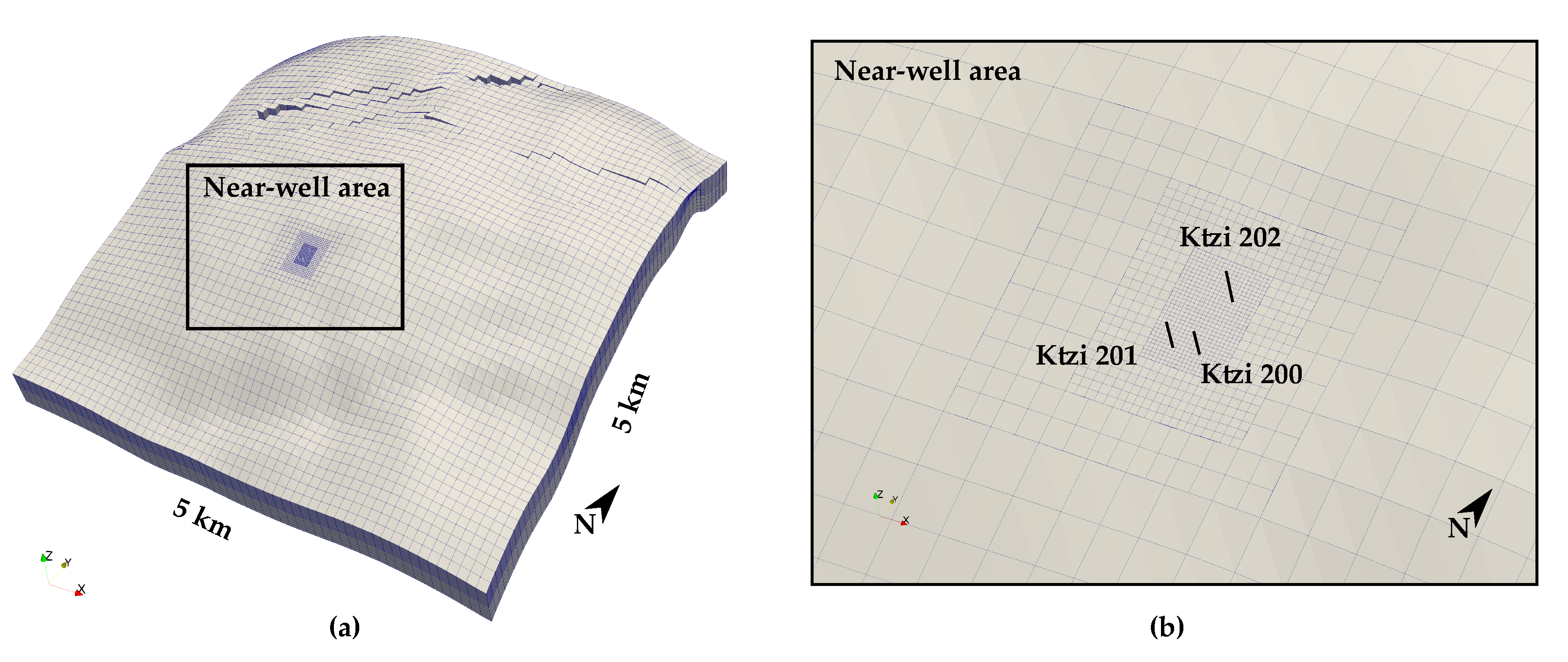
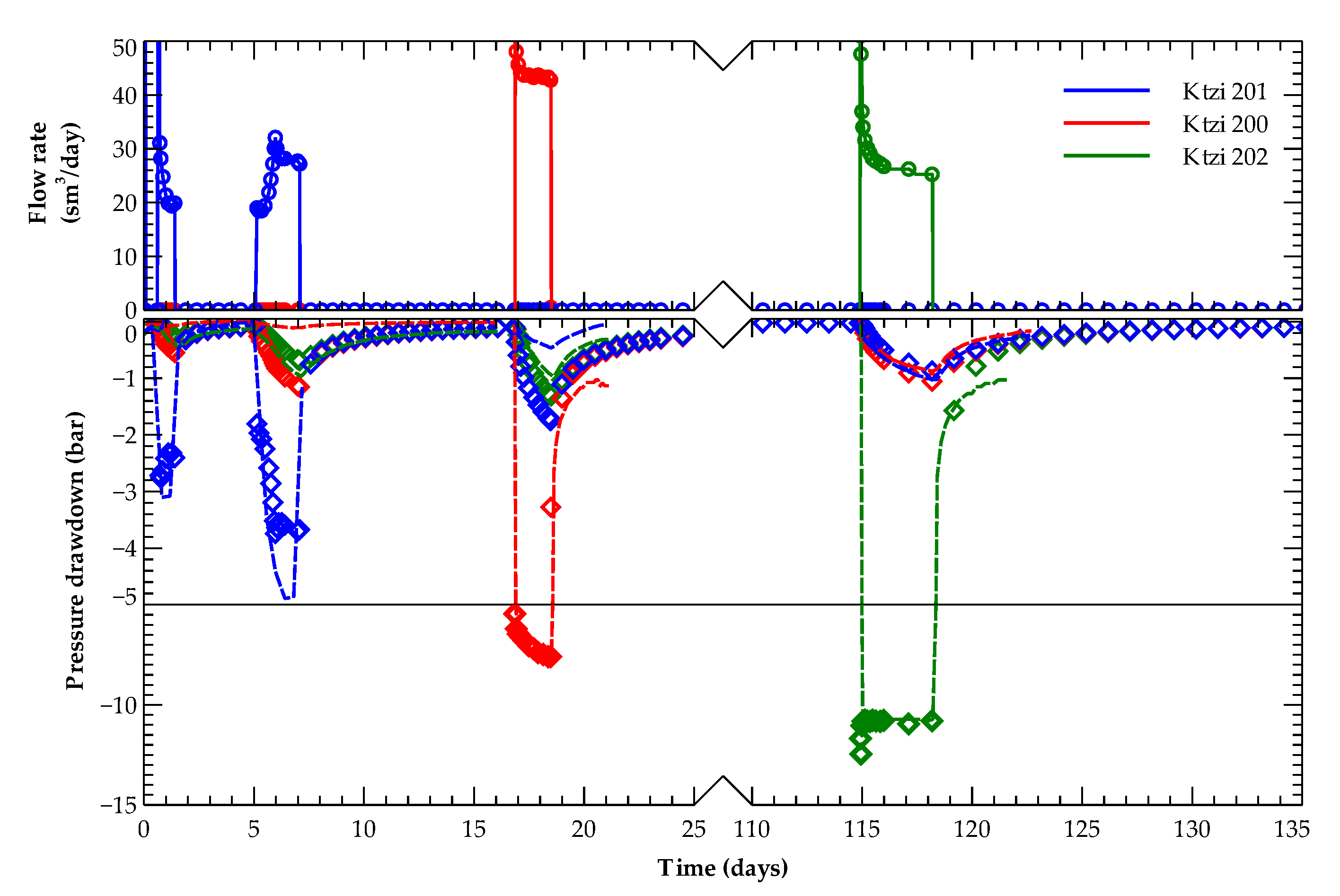
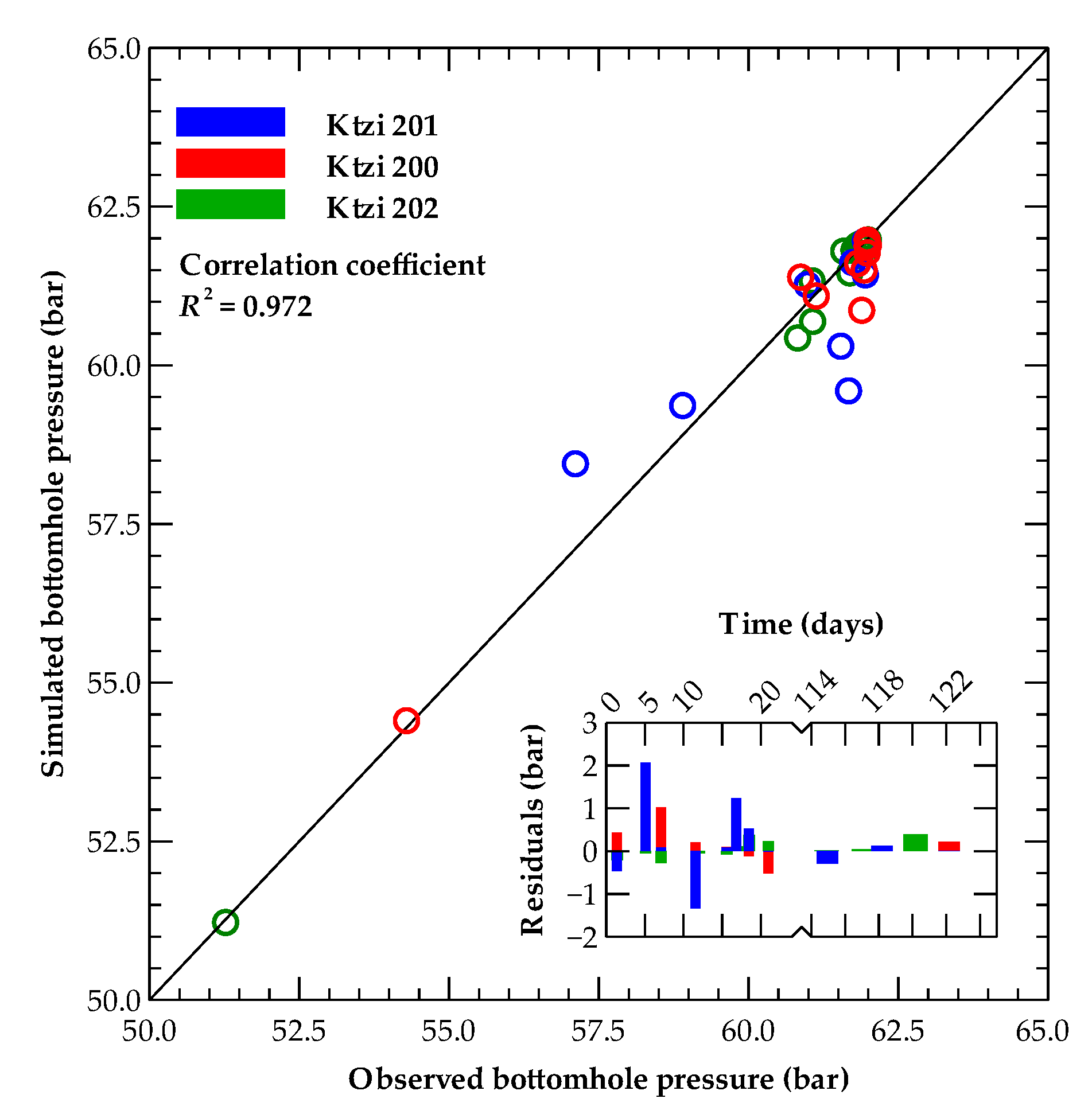
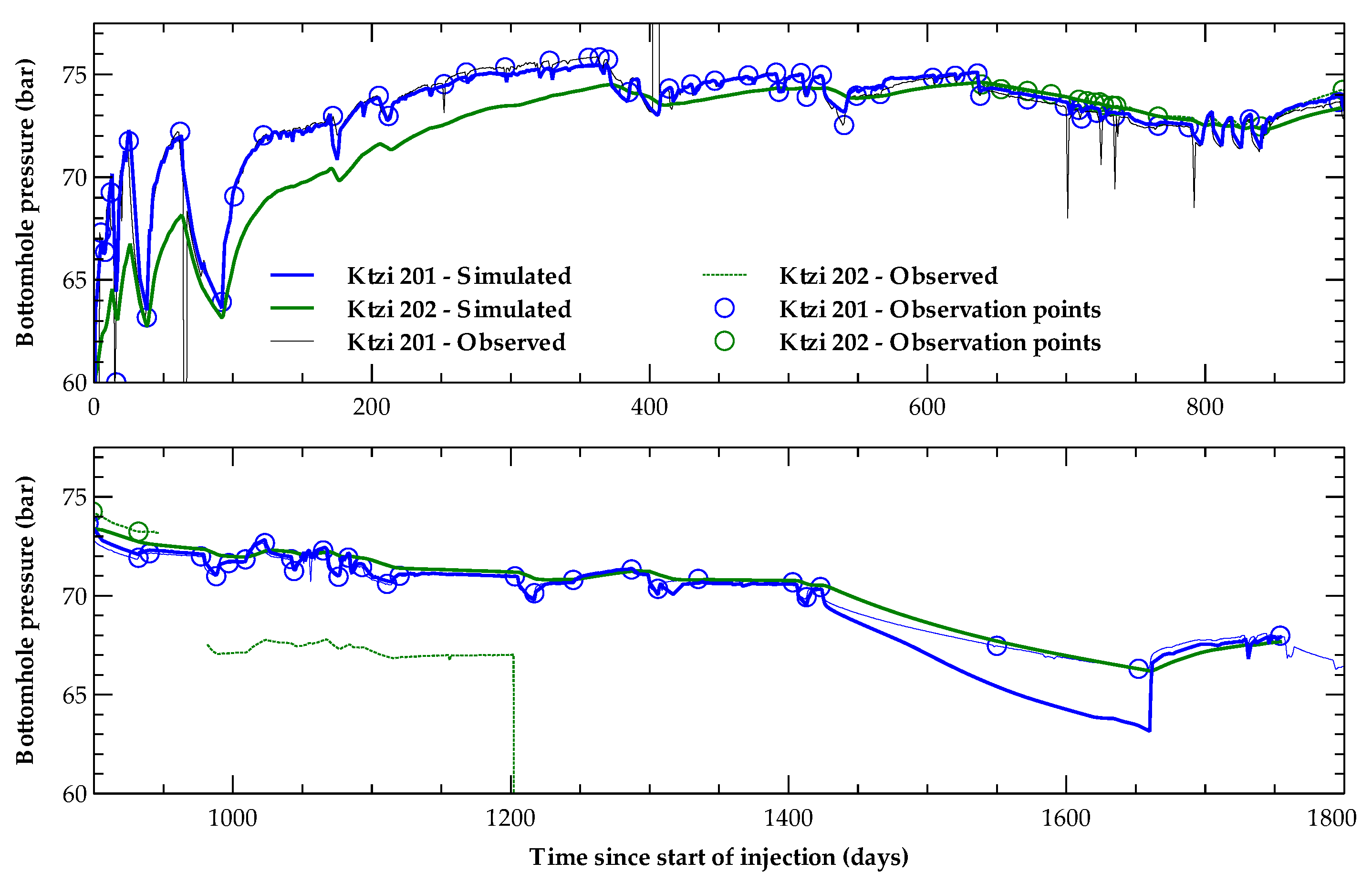

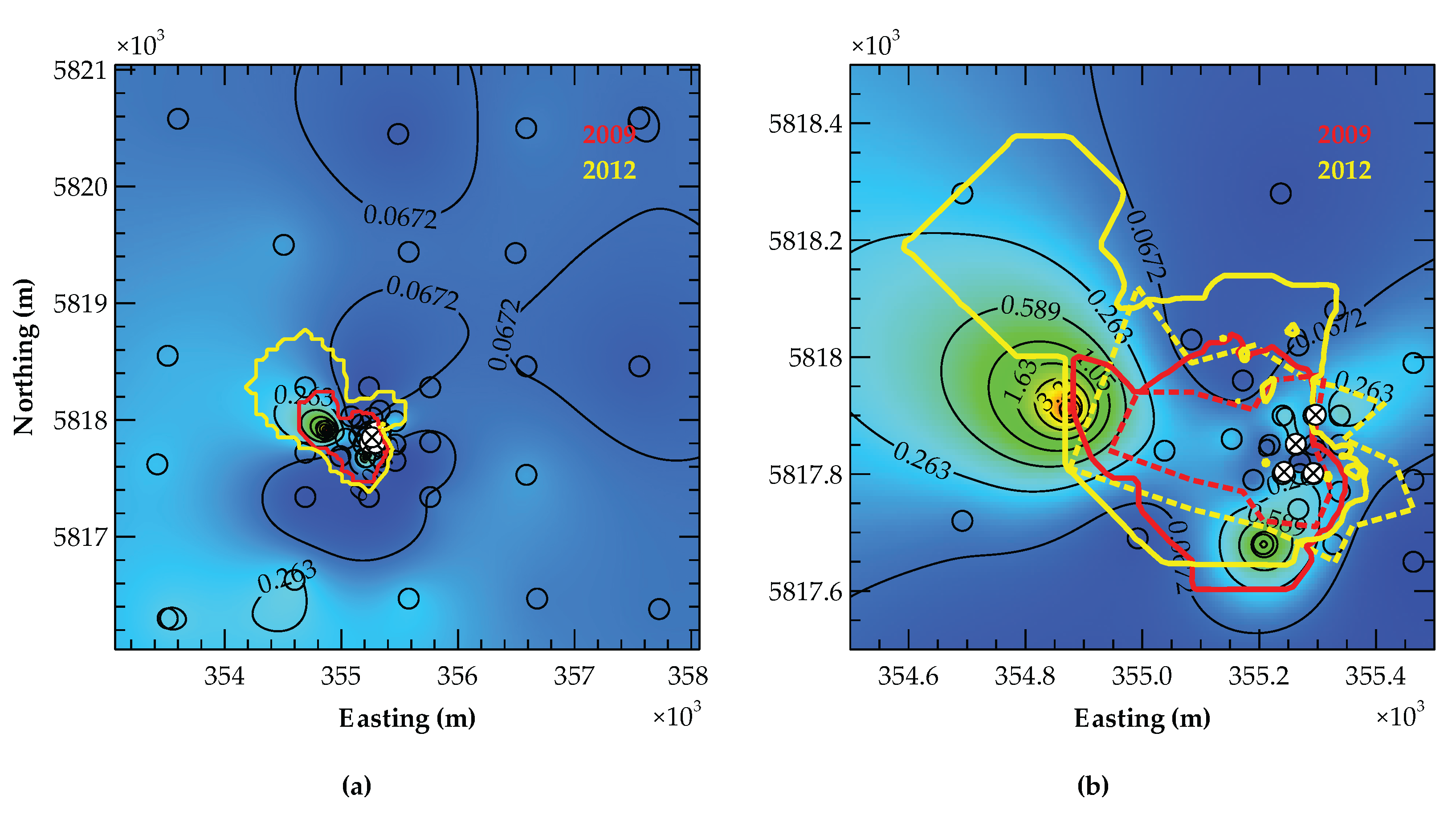
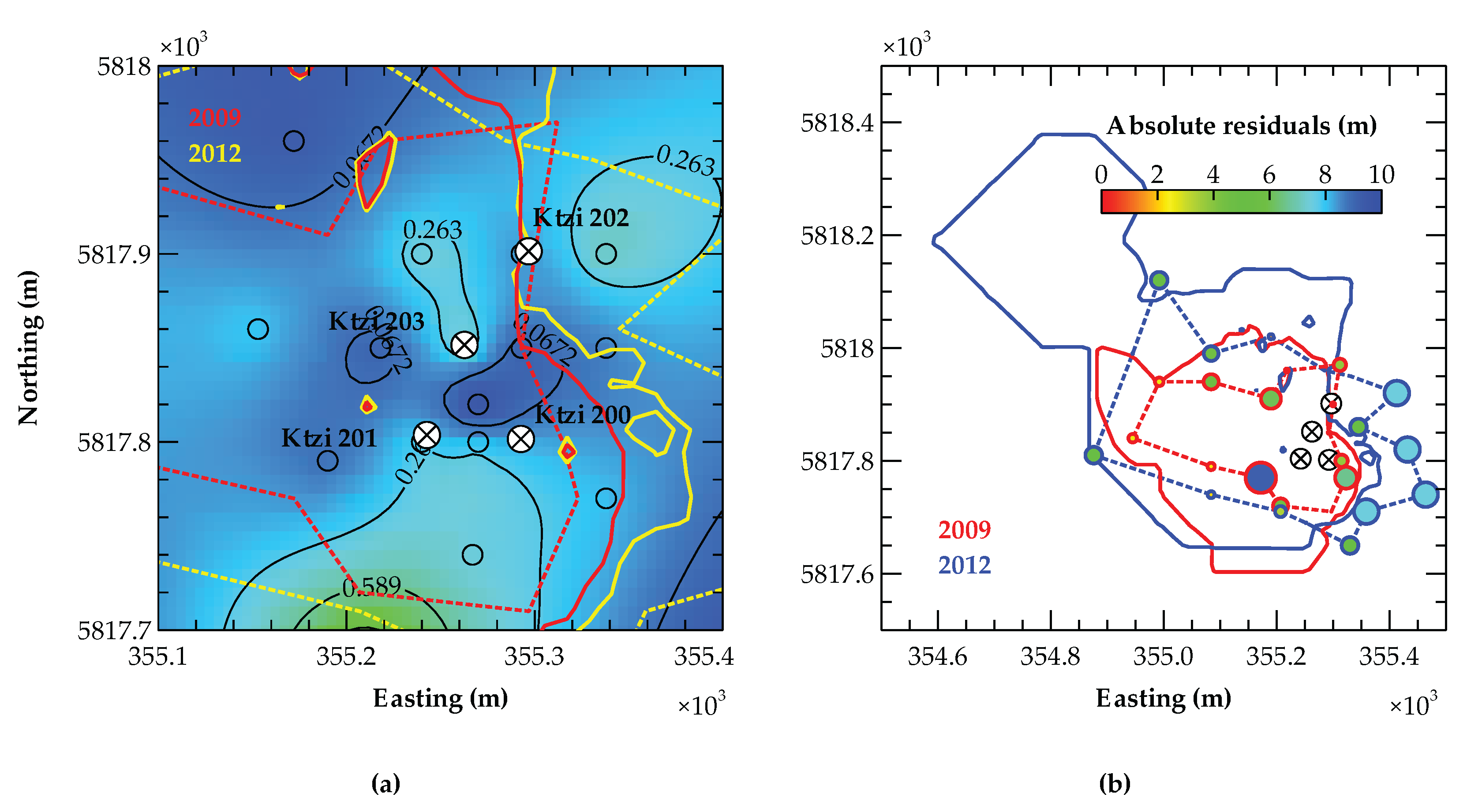
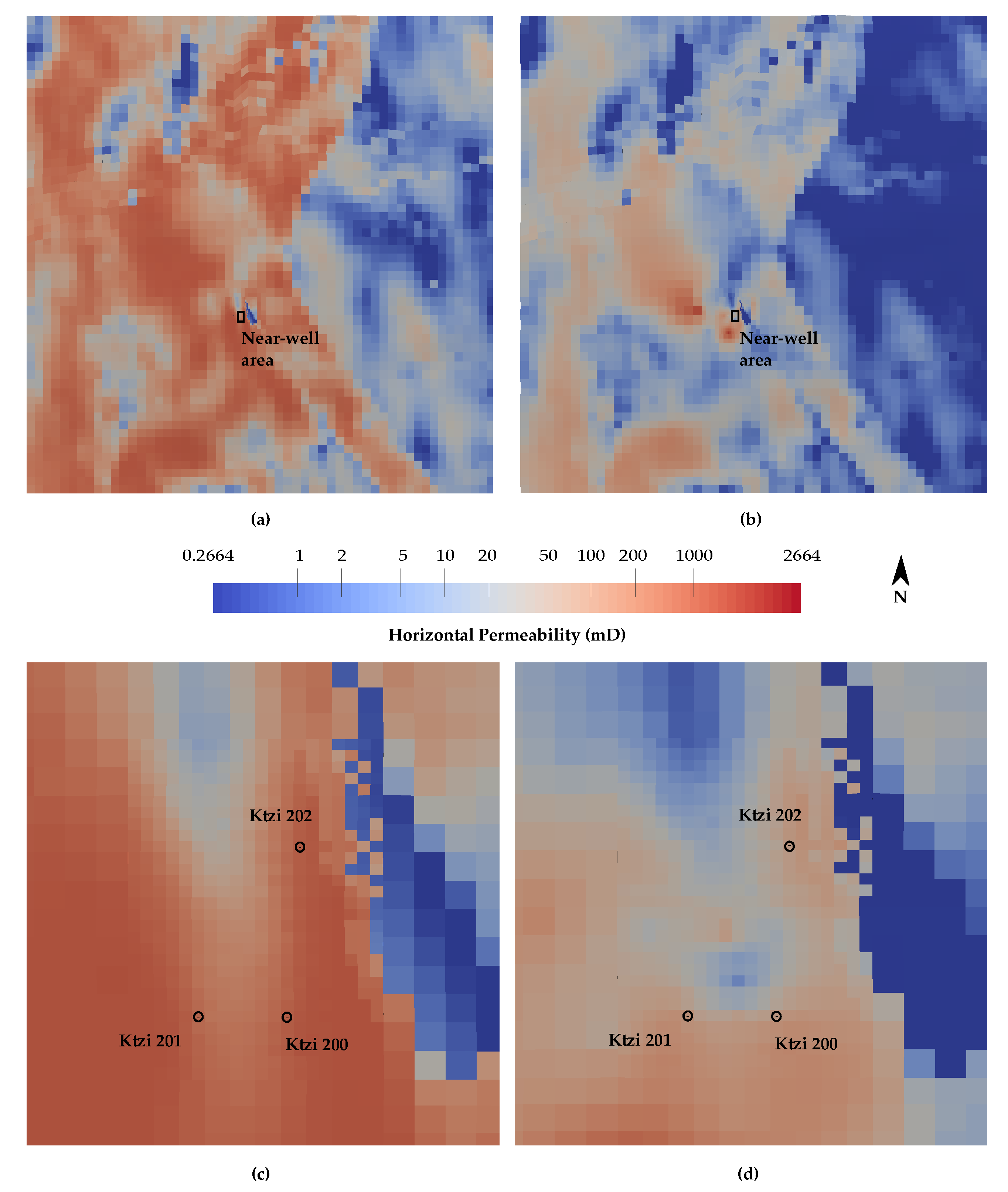
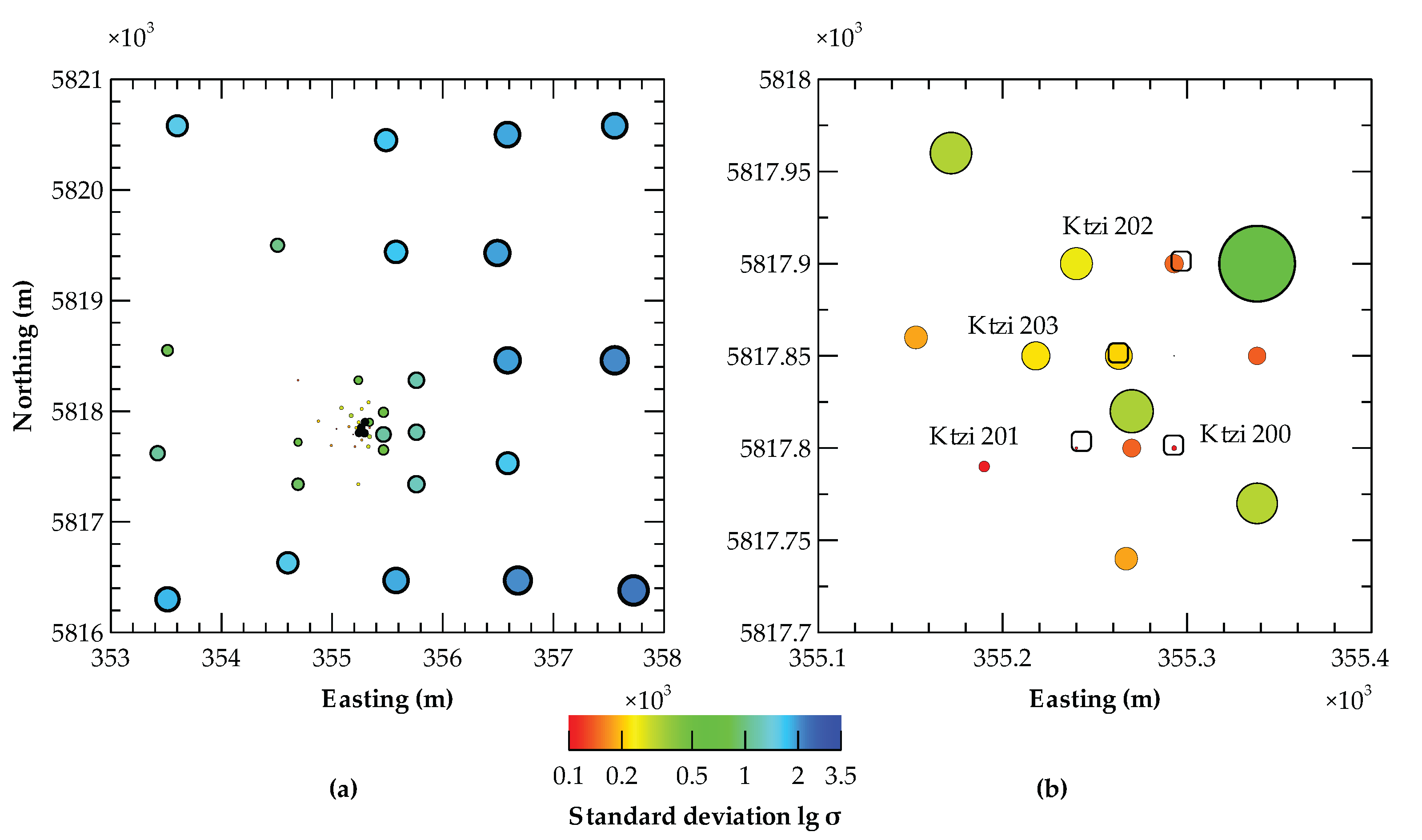
© 2017 by the authors. Licensee MDPI, Basel, Switzerland. This article is an open access article distributed under the terms and conditions of the Creative Commons Attribution (CC BY) license (http://creativecommons.org/licenses/by/4.0/).
Share and Cite
Kempka, T.; Norden, B.; Ivanova, A.; Lüth, S. Revising the Static Geological Reservoir Model of the Upper Triassic Stuttgart Formation at the Ketzin Pilot Site for CO2 Storage by Integrated Inverse Modelling. Energies 2017, 10, 1559. https://doi.org/10.3390/en10101559
Kempka T, Norden B, Ivanova A, Lüth S. Revising the Static Geological Reservoir Model of the Upper Triassic Stuttgart Formation at the Ketzin Pilot Site for CO2 Storage by Integrated Inverse Modelling. Energies. 2017; 10(10):1559. https://doi.org/10.3390/en10101559
Chicago/Turabian StyleKempka, Thomas, Ben Norden, Alexandra Ivanova, and Stefan Lüth. 2017. "Revising the Static Geological Reservoir Model of the Upper Triassic Stuttgart Formation at the Ketzin Pilot Site for CO2 Storage by Integrated Inverse Modelling" Energies 10, no. 10: 1559. https://doi.org/10.3390/en10101559
APA StyleKempka, T., Norden, B., Ivanova, A., & Lüth, S. (2017). Revising the Static Geological Reservoir Model of the Upper Triassic Stuttgart Formation at the Ketzin Pilot Site for CO2 Storage by Integrated Inverse Modelling. Energies, 10(10), 1559. https://doi.org/10.3390/en10101559




